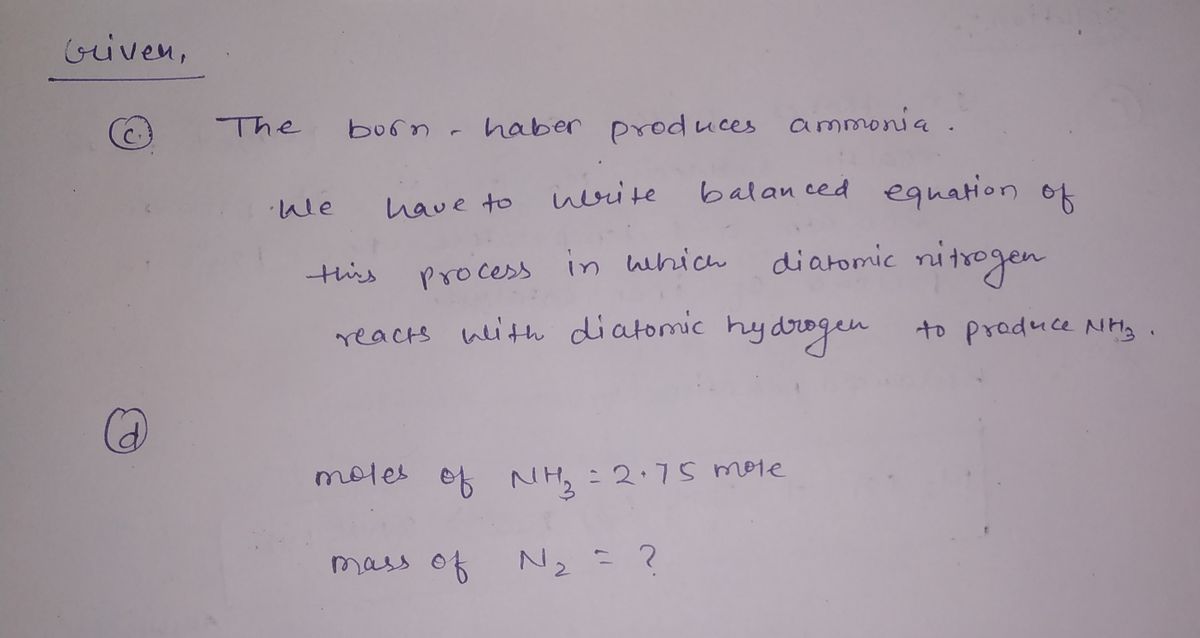C. the born- haber process is produces ammonia (NH3) and is responsible for the vast increase in agricultural production of the 20th century. Write and balance the equation for this process: diatomic nitrogen reacts with diatomic hydrogen to produce ammonia (NH3). D. How many grams of diatomic nitrogen (N2) are needed to produce 2.75 moles of ammonia?
C. the born- haber process is produces ammonia (NH3) and is responsible for the vast increase in agricultural production of the 20th century. Write and balance the equation for this process: diatomic nitrogen reacts with diatomic hydrogen to produce ammonia (NH3). D. How many grams of diatomic nitrogen (N2) are needed to produce 2.75 moles of ammonia?
Chemistry
10th Edition
ISBN:9781305957404
Author:Steven S. Zumdahl, Susan A. Zumdahl, Donald J. DeCoste
Publisher:Steven S. Zumdahl, Susan A. Zumdahl, Donald J. DeCoste
Chapter1: Chemical Foundations
Section: Chapter Questions
Problem 1RQ: Define and explain the differences between the following terms. a. law and theory b. theory and...
Related questions
Question
Annasb

Transcribed Image Text:**Transcription for Educational Website**
**C.** The Born-Haber process produces ammonia (NH₃) and is responsible for the vast increase in agricultural production of the 20th century. Write and balance the equation for this process: diatomic nitrogen reacts with diatomic hydrogen to produce ammonia (NH₃).
**D.** How many grams of diatomic nitrogen (N₂) are needed to produce 2.75 moles of ammonia?
**Explanation**: This text discusses the Born-Haber process, a vital industrial chemical process used to synthesize ammonia from nitrogen and hydrogen gases. It provides instructions to write and balance the chemical equation that describes this synthesis, and it poses a practical stoichiometry problem involving the calculation of necessary reactants for a given amount of product.
Expert Solution
Step 1

Step by step
Solved in 2 steps with 2 images

Knowledge Booster
Learn more about
Need a deep-dive on the concept behind this application? Look no further. Learn more about this topic, chemistry and related others by exploring similar questions and additional content below.Recommended textbooks for you

Chemistry
Chemistry
ISBN:
9781305957404
Author:
Steven S. Zumdahl, Susan A. Zumdahl, Donald J. DeCoste
Publisher:
Cengage Learning

Chemistry
Chemistry
ISBN:
9781259911156
Author:
Raymond Chang Dr., Jason Overby Professor
Publisher:
McGraw-Hill Education

Principles of Instrumental Analysis
Chemistry
ISBN:
9781305577213
Author:
Douglas A. Skoog, F. James Holler, Stanley R. Crouch
Publisher:
Cengage Learning

Chemistry
Chemistry
ISBN:
9781305957404
Author:
Steven S. Zumdahl, Susan A. Zumdahl, Donald J. DeCoste
Publisher:
Cengage Learning

Chemistry
Chemistry
ISBN:
9781259911156
Author:
Raymond Chang Dr., Jason Overby Professor
Publisher:
McGraw-Hill Education

Principles of Instrumental Analysis
Chemistry
ISBN:
9781305577213
Author:
Douglas A. Skoog, F. James Holler, Stanley R. Crouch
Publisher:
Cengage Learning

Organic Chemistry
Chemistry
ISBN:
9780078021558
Author:
Janice Gorzynski Smith Dr.
Publisher:
McGraw-Hill Education

Chemistry: Principles and Reactions
Chemistry
ISBN:
9781305079373
Author:
William L. Masterton, Cecile N. Hurley
Publisher:
Cengage Learning

Elementary Principles of Chemical Processes, Bind…
Chemistry
ISBN:
9781118431221
Author:
Richard M. Felder, Ronald W. Rousseau, Lisa G. Bullard
Publisher:
WILEY